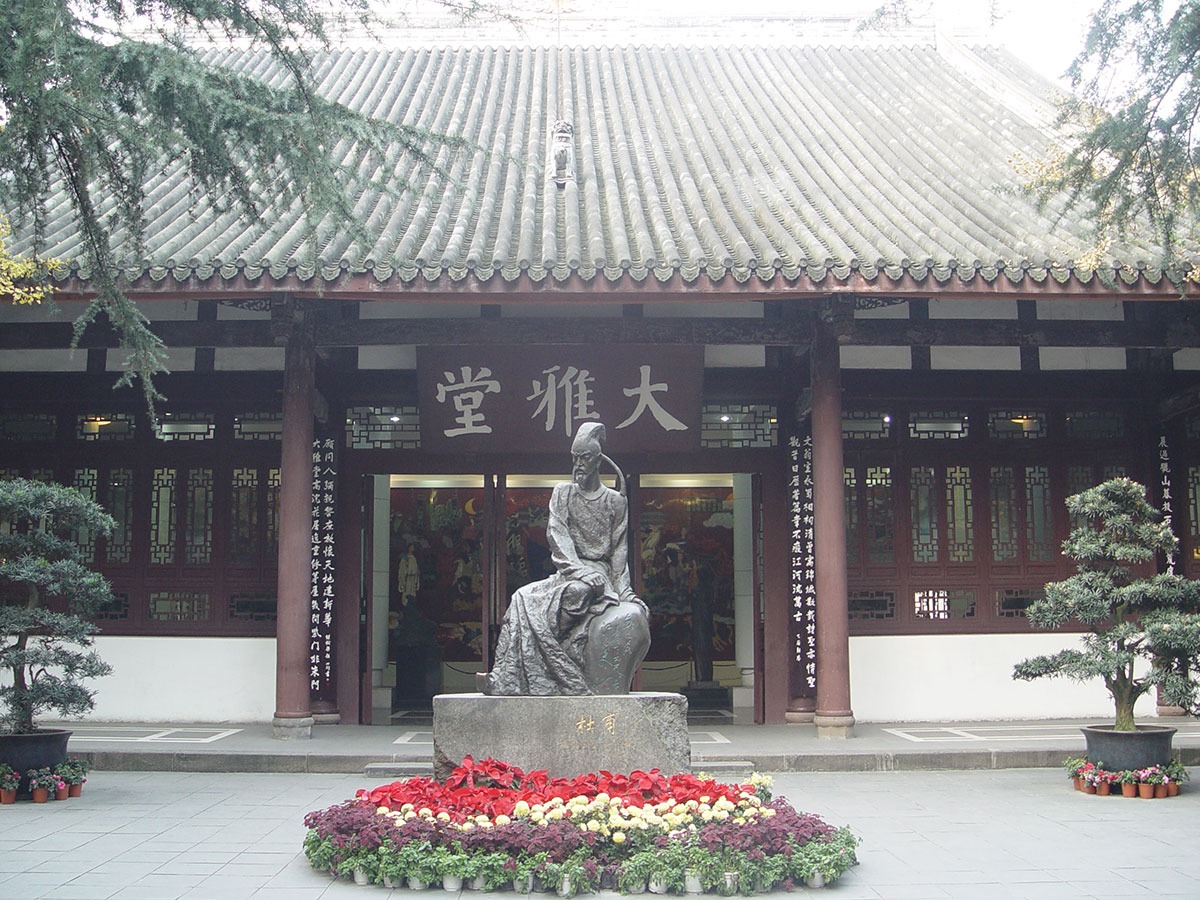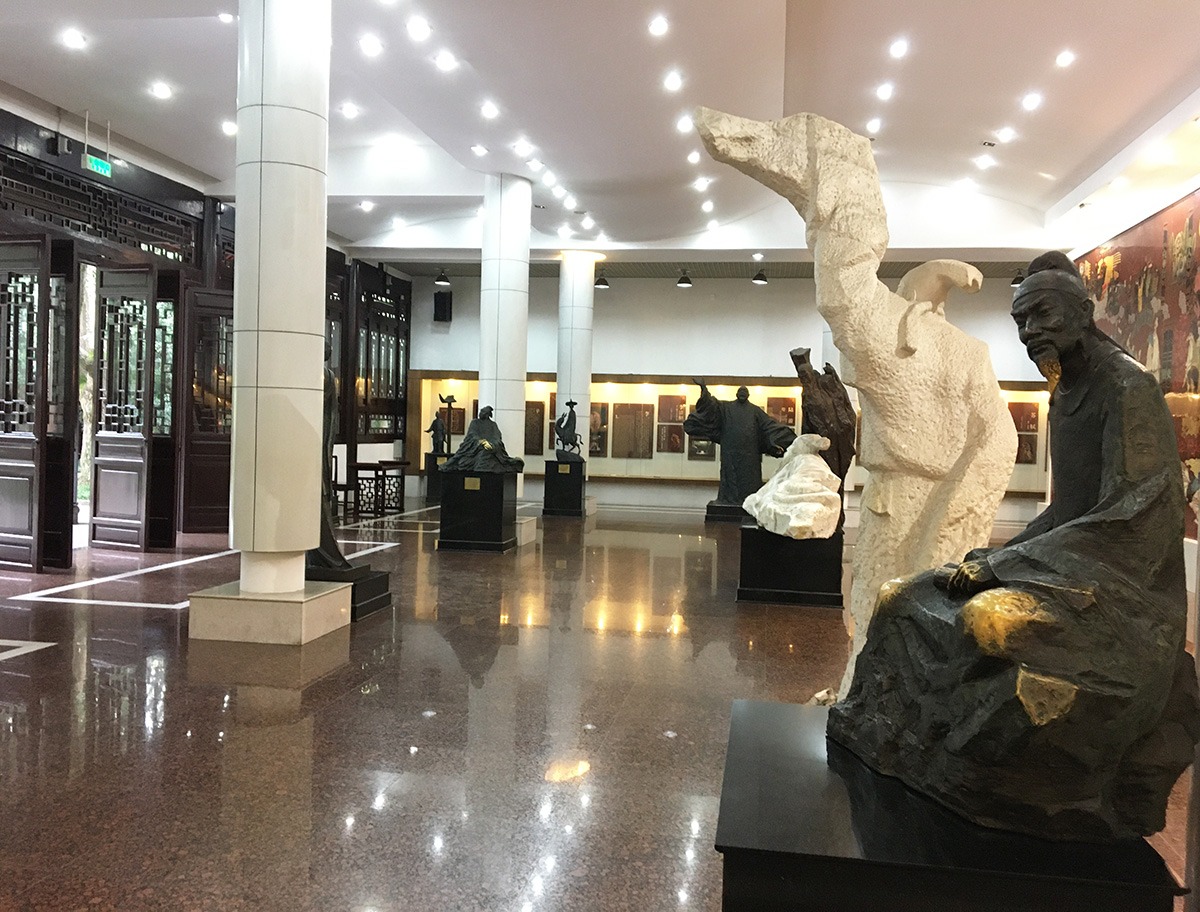


loading...


In our minds, Du Fu is a cultural symbol that represents the age of poetry and Chinese poetry culture, along with all the poets who created this age and culture. The Hall of Odes in front of us was formerly the Shakya Mani Hall of the Thatched Cottage Temple. Redesigned into a hall to exhibit Chinese poetry culture, it was opened to the public in 2002. The three characters “大雅堂” (Hall of Odes) inscribed on the board over the front gate are taken from handwritings of Yan Zhenqing, the prestigious calligrapher of the Tang Dynasty. “大雅” (Ode) is a part of the Book of Songs, the earliest poetry collection in China, which reflects major events in ancient society and is treated as the paragon of poetry. The Hall is thus named to show respect to the fine tradition of Chinese poetry. As a staunch fan of Du Fu’s poems, Yang Su from Danling of Sichuan in the Northern Song Dynasty once invited Huang Tingjian, a great poet who was demoted to Yibin of Sichuan at the time, to handwrite Du Fu’s poems composed in Sichuan; carved them all on stone tablets; and erected a hall in Danling for exhibition. Upon erection of the hall, Huang Tingjian named it Hall of Odes and composed an article entitled Records on the Hall of Odes.
The Hall exhibits twelve statues of poets, erected by renowned sculptors such as Qian Shaowu and Ye Yushan. The twelve figures are all outstanding poets in Chinese poetic history, including Du Fu’s predecessors Qu Yuan, Tao Yuanming and Chen Zi’ang; contemporaries Wang Wei and Li Bai; and successors Bai Juyi, Li Shangyin, Su Shi, Huang Tingjian, Lu You, Li Qingzhao and Xin Qiji. Centering on Du Fu, the middle link, the Hall of Odes demonstrates the development path of Chinese poetic history and the brilliant tradition starting from the pre-Qin Period.
Right in front is a large mosaic mural with colored glaze, which generalizes the life and poetic creation of Du Fu through vivid images and concise brushwork. Pigments used for the mural are all made of natural minerals and ingredients, which preserve a simple and dignified style with magnificent colors, arousing a special aesthetic perception. 16m long and 4m wide, the mural illustrates six chapters of Du Fu’s life, i.e., travel in prime age, plight in Chang’an, escape from warfare, relocation in Chengdu, short stay in Kuifu, and drifting in Hunan in “∞” layout.
Du Fu has been honored as the poet sage and a great master of Chinese poetry for his extensive knowledge, lofty ideals, refined poetry writing skills, and tremendous literary achievement. He deserves the title poet sage, as commented by modern poet Wen Yiduo that “Du Fu marks the noblest, brightest and longest-lasting ray in the four millennia of Chinese cultural history.” Hailed as a scared place of Chinese culture and literature, the Du Fu Thatched Cottage is the materialization and extension of Du Fu’s spirit.
In our minds, Du Fu is a cultural symbol that represents the age of poetry and Chinese poetry culture, along with all the poets who created this age and culture. The Hall of Odes in front of us was formerly the Shakya Mani Hall of the Thatched Cottage Temple. Redesigned into a hall to exhibit Chinese poetry culture, it was opened to the public in 2002. The three characters “大雅堂” (Hall of Odes) inscribed on the board over the front gate are taken from handwritings of Yan Zhenqing, the prestigious calligrapher of the Tang Dynasty. “大雅” (Ode) is a part of the Book of Songs, the earliest poetry collection in China, which reflects major events in ancient society and is treated as the paragon of poetry. The Hall is thus named to show respect to the fine tradition of Chinese poetry. As a staunch fan of Du Fu’s poems, Yang Su from Danling of Sichuan in the Northern Song Dynasty once invited Huang Tingjian, a great poet who was demoted to Yibin of Sichuan at the time, to handwrite Du Fu’s poems composed in Sichuan; carved them all on stone tablets; and erected a hall in Danling for exhibition. Upon erection of the hall, Huang Tingjian named it Hall of Odes and composed an article entitled Records on the Hall of Odes.
The Hall exhibits twelve statues of poets, erected by renowned sculptors such as Qian Shaowu and Ye Yushan. The twelve figures are all outstanding poets in Chinese poetic history, including Du Fu’s predecessors Qu Yuan, Tao Yuanming and Chen Zi’ang; contemporaries Wang Wei and Li Bai; and successors Bai Juyi, Li Shangyin, Su Shi, Huang Tingjian, Lu You, Li Qingzhao and Xin Qiji. Centering on Du Fu, the middle link, the Hall of Odes demonstrates the development path of Chinese poetic history and the brilliant tradition starting from the pre-Qin Period.
Right in front is a large mosaic mural with colored glaze, which generalizes the life and poetic creation of Du Fu through vivid images and concise brushwork. Pigments used for the mural are all made of natural minerals and ingredients, which preserve a simple and dignified style with magnificent colors, arousing a special aesthetic perception. 16m long and 4m wide, the mural illustrates six chapters of Du Fu’s life, i.e., travel in prime age, plight in Chang’an, escape from warfare, relocation in Chengdu, short stay in Kuifu, and drifting in Hunan in “∞” layout.
Du Fu has been honored as the poet sage and a great master of Chinese poetry for his extensive knowledge, lofty ideals, refined poetry writing skills, and tremendous literary achievement. He deserves the title poet sage, as commented by modern poet Wen Yiduo that “Du Fu marks the noblest, brightest and longest-lasting ray in the four millennia of Chinese cultural history.” Hailed as a scared place of Chinese culture and literature, the Du Fu Thatched Cottage is the materialization and extension of Du Fu’s spirit.

Location: No. 37, Qinghua Road, Qingyang District, Chengdu City [Online Map]
Tel::028-68921800(Ticket Consultation)
Tel:028-87327392(Emergency Rescue)